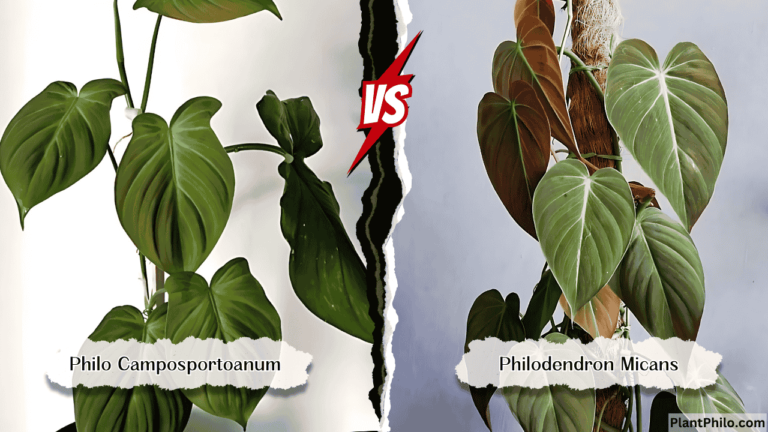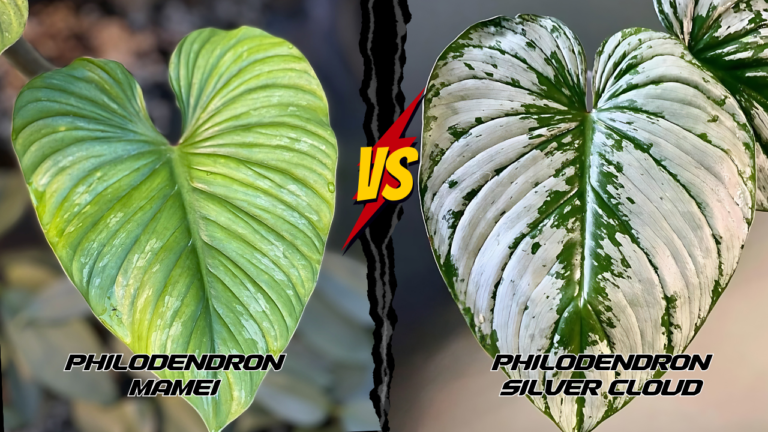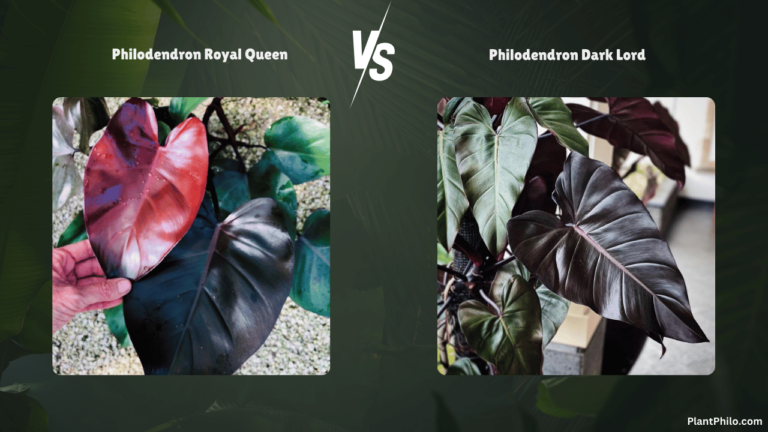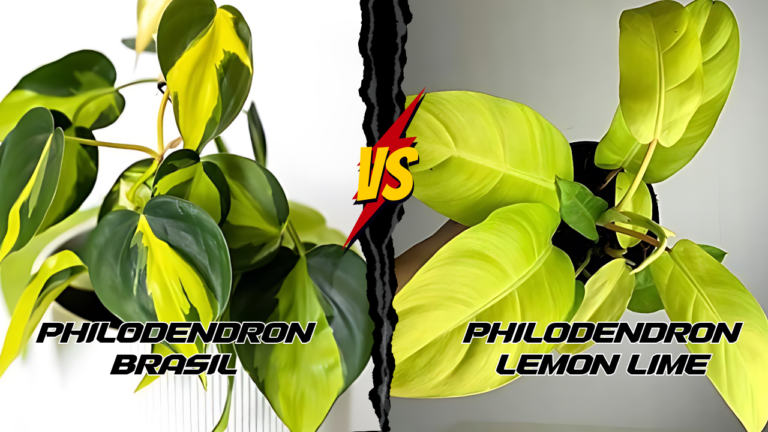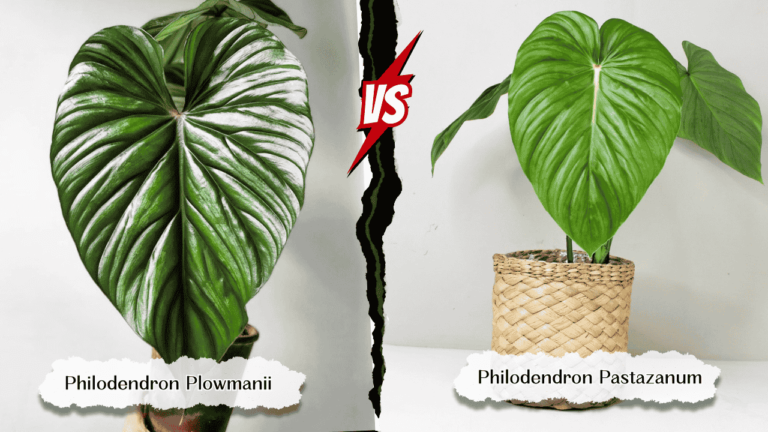Mayoi or Tahiti? Crack the Code of These Look-Alike Philodendrons
Philodendron Mayoi or Tahiti? These two plants are practically twins, but trust me, getting them mixed up is a recipe for a sad, droopy houseplant. Don’t let their leafy charm fool you. I’ll spill the secrets on how to tell them apart (and keep them happy!) so you can confidently rock your plant parent status.
Philodendrons, with their lush foliage and easy care, are beloved houseplants. However, confusion often arises between Philodendron Mayoi and Philodendron Tahiti due to their similar appearances. It’s crucial to grasp the key differences between these two plants to make the right choice for your home.
Philodendron Mayoi features deeply lobed, solid green leaves that can develop a slight sheen. In contrast, Philodendron Tahiti has similar leaves but with sharper lobes and sometimes a slight reddish tinge. Mayoi stems are usually green or slightly brown, while Tahiti stems can appear reddish or even burgundy.
| Feature | Philodendron Mayoi | Philodendron Tahiti |
| Leaf Shape | Deep lobes, rounded points | Sharper, more defined lobes |
| Leaf Color | Solid green, slight sheen | Slight reddish tinge (young), may develop variegation or bronze undertones |
| Stem Color | Green or slightly brown | Reddish or burgundy |
| Petiole (Leaf Stalk) | Green or slightly reddish | Deeper red or burgundy |
| Growth Habit | More compact, climbing vine | Larger, sprawling vine |
| Care Requirements | Bright, indirect light, well-draining soil, water when top inch of soil is dry | Bright, indirect light, well-draining soil that retains slightly more moisture, water when top inch of soil is dry |
| Other Notes | May be easier for beginners | May grow slower, needs more space |
| Price Range (approx.) | Less expensive | $35 to $100 |
Both Philodendron Mayoi and Tahiti, as climbing vines, thrive with bright, indirect light and well-draining soil. The color of the petioles and stems can help you differentiate between them. Rest assured, this guide will equip you with the knowledge to easily identify and care for these beautiful plants, making your gardening journey a breeze.
Key Takeaways
- Philodendron Mayoi and Tahiti have distinct leaf and stem colors.
- Both plants need bright, indirect light and a well-draining soil mix.
- Stems and petioles offer clues to differentiate between them.
Taxonomic Breakdown
Philodendron Mayoi and Philodendron sp. ‘Tahiti’ are often confused due to their similar appearance. Below, you’ll find detailed information on their scientific names to help you distinguish between the two.
Scientific Names: Philodendron Mayoi vs. Philodendron sp. ‘Tahiti’
Philodendron Mayoi is a species, while Philodendron sp. ‘Tahiti’ is a cultivar. Mayoi is recognized for its deeply lobed, fern-like leaves and its origin in South America.
The cultivar ‘Tahiti’ doesn’t correspond to a single species but rather a selected plant with desirable traits. It typically features large, deeply cut leaves and a more mounding growth habit.
Knowing the taxonomic distinctions between these plants can help you choose the right one for your collection and avoid confusion.
Visual Comparison: Leaves
Philodendron Mayoi and Tahiti have some key differences and similarities in their leaves. Understanding these can help you tell them apart and appreciate their unique beauty.
Shape
Philodendron Mayoi:
- Young leaves: The shape is oval or heart-shaped.
- Mature leaves: These leaves are glossy and dark green. They have deep lobes that have rounded points, which remind one of palm fronds.
Philodendron Tahiti:
- Similar to Mayoi when young.
- Lobes become sharper and more defined as they mature, creating a distinct pattern.
Color
Philodendron Mayoi:
- Solid green leaves, sometimes with a slight sheen.
- Consistent coloration adds to its lush appearance.
Philodendron Tahiti:
- Leaves can have a slight reddish tinge when young.
- May develop subtle variegation or bronze undertones with high light exposure.
Size
Both:
- Leaves can grow up to 8-12 inches long in ideal conditions.
- Size may vary based on care, light, and overall environment.
Veins
Both:
- Prominent veins run throughout the leaves.
- Lighter green or yellow color for veins, creating a striking contrast against the dark green leaf surface.
Stems
Philodendron Mayoi:
- Stems are green or slightly brown.
- Relatively thin compared to other philodendrons.
Philodendron Tahiti:
- Stems can have a reddish or burgundy hue.
- Often thicker and more robust than Mayoi.
Petioles
Philodendron Mayoi:
- Petioles (leaf stalks) are green or slightly reddish.
- It matches the color of the stems closely.
Philodendron Tahiti:
- Petioles are usually a deeper red or burgundy.
- More prominent than Mayoi, adding to the plant’s unique look.
Growth Habit and Care
Philodendron Mayoi and Philodendron ‘Tahiti’ are popular for their unique looks but differ in growth style and care requirements. Learn how these plants thrive best in your home or garden.
Growth Pattern
Both Philodendron Mayoi and Tahiti grow as climbing vines. They do well with some support, like a moss pole or trellis, which helps them grow taller and healthier. Mayoi tends to be more compact, while Tahiti can grow quite large with more sprawling leaves.
If you prefer a plant that takes up less space, Mayoi might be the better choice. Tahiti requires more room to spread out and can become a stunning centerpiece if given enough space.
Light
Philodendron Mayoi and Tahiti both love bright, indirect light. Placing them near a window where they get soft, filtered sunlight is ideal. Direct sunlight can scorch their leaves, leading to brown spots or faded color.
If you notice your plant looking pale, it might need more light. Conversely, if it’s developing brown spots, it’s getting too much. Adjust the light conditions accordingly to keep your plant healthy and vibrant.
Watering
Good watering practices are key for thriving Philodendrons. Water your Philodendron Mayoi or Tahiti when the top inch of soil feels dry to the touch. Overwatering can lead to root rot, a common issue for these plants.
Make sure the pot has drainage holes to prevent water from accumulating at the bottom. During winter, you might need to water less frequently as growth slows down. Pay attention to the soil moisture and adapt as needed.
Soil
Both Philodendron Mayoi and Tahiti thrive in well-draining soil mixes. An aroid mix, which usually contains peat, perlite, and orchid bark, works great. This type of soil mix helps retain moisture without becoming waterlogged, providing the right balance for healthy root growth.
Avoid using garden soil or dense potting soil as it can retain too much water and suffocate the roots. Repot your plant every couple of years to refresh the soil and provide more room for growth.
Additional Notes
Philodendron Tahiti might grow slower compared to Mayoi. Tahiti also tends to be a bit more demanding in terms of space and light. If you’re new to philodendrons, you might find Mayoi easier to manage.
Both plants benefit from regular misting to maintain humidity levels, especially during dry periods. For optimal growth, consider using a balanced liquid fertilizer during the growing season. This encourages lush foliage and stronger plant health.
Identification Tips (for resolving confusion)
To tell Philodendron Mayoi and Tahiti apart, you can focus on a few key features.
First, look at the petiole (leaf stalk) color. Philodendron Tahiti has a deeper red, almost burgundy petiole, while Philodendron Mayoi has a green to slightly reddish petiole that matches the stem quite closely.
Next, observe the stem color. Philodendron Tahiti’s stems often have a reddish or burgundy tinge, sometimes described as “blackish”, and are thicker than Philodendron Mayoi’s. Mayoi stems are generally green or slightly brown and more slender.
Leaf Shape and Texture:
- Philodendron Mayoi:
- Young leaves: heart-shaped or oval.
- Mature leaves: develop deep lobes with rounded points.
- Texture: solid green, sometimes with a slight sheen.
- Philodendron Tahiti:
- Similar shape to Mayoi, but with sharper and more defined lobes.
- Color: can have a slight reddish tinge on young leaves and develop subtle variegation or bronze undertones with high light exposure.
Growth Habit:
- Both types are climbing vines that benefit from support, like a moss pole or trellis.
- They prefer bright, indirect light and should not be exposed to direct sunlight, which can scorch the leaves.
- Water when the top inch of soil dries out, and use a well-draining aroid mix for the soil to avoid overwatering.
By focusing on these visual cues, you can confidently distinguish between these two stunning philodendrons. For more details, you can check out information on Philodendron Mayoi care and Philodendron Tahiti care.
Frequently Asked Questions
Philodendron Mayoi and Tahiti both have unique features and care needs. Understanding these can make it easier to choose the right one for your home.
What are the main differences in care requirements for Philodendron Mayoi and Tahiti?
Philodendron Mayoi prefers well-draining soil rich in organic matter. Keep the soil moist but not waterlogged. Tahiti, on the other hand, needs soil that retains moisture a bit more, although it shouldn’t be waterlogged either. Both plants enjoy bright, indirect light and should be watered when the top inch of soil dries out.
How can you tell a Philodendron Mayoi apart from a Tahiti?
Philodendron Mayoi has green stems that might be slightly brown, while Tahiti’s stems often have a reddish or burgundy color. The leaf shape is also a clue: Mayoi’s mature leaves have deep lobes with rounded points, whereas Tahiti’s lobes tend to be sharper and more defined.
What’s the typical mature size of a Philodendron Mayoi compared to a Tahiti?
Under ideal conditions, both plants can have leaves that grow up to 8-12 inches long. While the mature size of the leaves is similar, the overall plant size and growth rate may differ slightly, with Tahiti sometimes growing a bit slower than Mayoi.
Are there unique features that differentiate Philodendron Mayoi from Tahiti?
One unique feature of Philodendron Mayoi is its climbing habit, which requires support like a moss pole or trellis. Tahiti’s young leaves might show a slight reddish tinge, and its stem and petiole colors can be a deeper red or burgundy than Mayoi’s.
Is there a notable difference in rarity and price between Philodendron Mayoi and Philodendron Tahiti?
Philodendron Tahiti can be found for $35 to $100, depending on size and location. In certain regions like Australia, it’s cheaper than in the US or Canada. On the other hand, Mayoi is also a popular choice but typically less expensive than some larger or rare Philodendron varieties.
Can Philodendron Mayoi or Tahiti be considered toxic to pets or humans?
Yes, both Philodendron Mayoi and Tahiti are considered toxic to pets and humans. They contain calcium oxalate crystals, which can irritate when ingested. To avoid any issues, keep them out of the reach of curious pets and young children.

